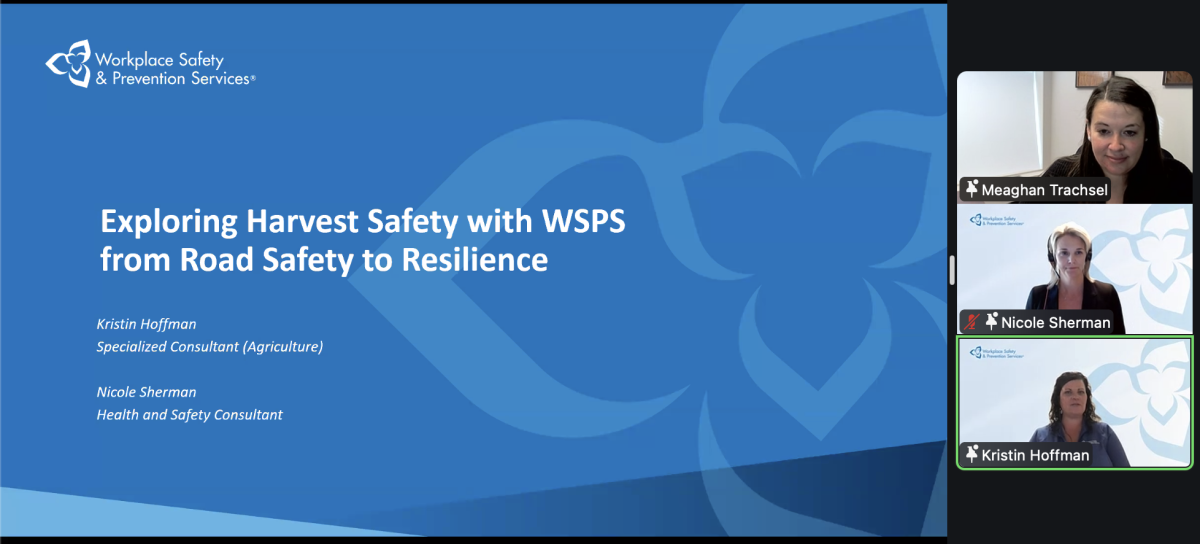If Canada wants an globally competitive ag industry, it’s not going to get it through public policy focused on farm income support rather than business support, a new report warns.
University of Manitoba economics professor Greg Mason, writing for the Calgary-based Canada West Foundation, said in his report released Tuesday that policy “must shift from a model that resembles social assistance to one that improves international competitiveness.”
Recent ag policy, particularly on the Praires, has made “important steps in the right direction” but still offers “contradictory incentives, combining elements of a social safety net for families with industrial policy,” said Mason, who’s also a managing partner with PRA (Prairie Research Associates) Inc., a policy analysis firm.
Read Also

Exploring Harvest Safety
Kristin Hoffman of WSPS explains measures for increased farm safety around harvest season
National policy goals of ag income safety nets, risk management, environmental responsibility, food safety and promoting capital investment for expansion “are supported by myriad subsidies, penalties, regulations, and moral suasion that present an incoherent context for meeting international competition and sustaining domestic economic prosperity,” Mason wrote.
Rather, he said, policy should focus on the growth of farms as businesses that don’t need “chronic subsidization.” Current policy, he wrote, “pays lip service to this, but many other actions undermine fulfilment of this goal.”
Mason, not unlike other pro-deregulation ag policy analysts in recent years, points to New Zealand and Australia as countries where deregulation has improved the sector’s viability, but at the cost of “hastening the exit of many long-time farmers with unviable operations.”
The social cost of those farms folding “would seem to be an inevitable price in the transformation of agriculture” and has also hindered efforts to refocus ag policy on the business model.
“Gradualism”
But Mason also cautions that comparing Canada with New Zealand and Australia requires care, particularly because these countries are on “isolated continents and islands.”
Furthermore, New Zealand agriculture’s scale and scope is smaller than that in Canada; also, in New Zealand, a “macroeconomic crisis forced the government’s hand” in policy reform.
The “gradualism” model in Australia may better suit Canada, Mason wrote, but added that Australia’s recent experience in deregulating its wheat board, AWB, “will offer little guidance on the net benefits of such a policy, at least until the kickback scandal dies completely.”
(Australia moved to deregulate AWB in the wake of a scandal that found the board had given kickbacks to the former Saddam Hussein government in Iraq under the United Nations oil-for-food program, from 1999 until shortly before the U.S.-led coalition invasion of Iraq in 2003.)
In Canada, Mason said, farm supports stem in part from “a political
choice validated by a democratic process” to support rural lifestyles. As an example he cited the recent Senate report on rural poverty, which “takes it as a given that special policy prescriptions are needed to support rural Canada, and it starts with an examination of support for farm families.”
For example, the senators had argued for a continuation for the federal Farm Families Options Program, “essentially a form of guaranteed annual income for low-income farm families,” Mason wrote.
“Subsidizes placeholders”
Options operates in addition to the support programs available under the federal/provincial Growing Forward framework, but rather than transform agriculture, Mason wrote, Options “effectively subsidizes rural placeholders rather than functional elements of a vibrant economy.
“It is difficult to justify the $550 million earmarked (but not fully spent) for this program, directed to only a fraction of rural residents,” he added.
“The inevitable fact is that policies that do not focus on economic viability are bound to maintain rural residents in perpetual dependency. For farmers, who repeatedly avow independence and self-reliance, social welfare policies seem anachronistic.”
Among his specific recommendations for Prairie ag policy, Mason urged that the Canadian Wheat Board be transformed into a “farmer-owned grain marketing company…freed of other responsibilities that can easily be
Similarly, Mason said, arrangements such as Canada’s supply management system for dairy, eggs and poultry distort market signals. Furthermore, he said, “farmers under supply management tend to have higher incomes than the average Canadian family. This implies that these arrangements involve a transfer of income from poorer to richer families.”
As well, Mason called for revival of public investment in basic ag research and extension services. “While the trend in research and development is to either joint-venture with private companies or the pharmaceutical model, which can result in important developments, over-reliance on private sector research will not ensure developments that align closely with the interests of farmers.”
If the public expects farmers to create stronger business, government can usefully parallel investments in basic research and the provision of technical advice. “These are key public goods, which the private sector will undersupply without government support,” Mason said.
“Cross purposes”
As an example of how effective policy development has been stymied in Prairie agriculture, Mason told the story of meeting with farmers around Portage la Prairie, Man. as part of an economic impact study over 15 years ago, when the federal government decided to close the training air base near the city.
For one group of five farmers in their early 30s, “the base closure was a calamity that threatened their ability to maintain their agricultural activities” as “winter snow clearing contracts and summer grass cutting formed an important element of their household income.”
Each of the farmers’ holdings was under 1,000 acres and each of the farmers said they “could never survive solely on selling farm outputs. The spouses of all five farmers also had at least part-time employment.”
The group, Mason said, “clung tenaciously to traditional farming, insisted on owning their major equipment, and refused to consolidate or share equipment. This illustrates the predominant view that agriculture is a chronically failing enterprise, requiring off-farm activity and public subsidization to remain afloat.”
Another interview with a farmer was cancelled five times, the last one due to the farmer getting a 4 a.m. fax confirming a sale of navy beans to Japan and driving to North Dakota that day to make the delivery, Mason said.
“During the interview he reported that he travelled to Europe twice a year to meet buyers for his mustard and was leasing more property to expand his operation. He also used currency hedging to manage financial risks of cross-border selling.”
This dual face of agriculture, Mason wrote, “presents an acute dilemma: policies that support the first type of farmer often work at cross-purposes for the second type of farmer and vice versa. In this paper, I argue that, in 2009, policy must focus on the second farmer, while helping the first to make an orderly retreat from the industry.”















